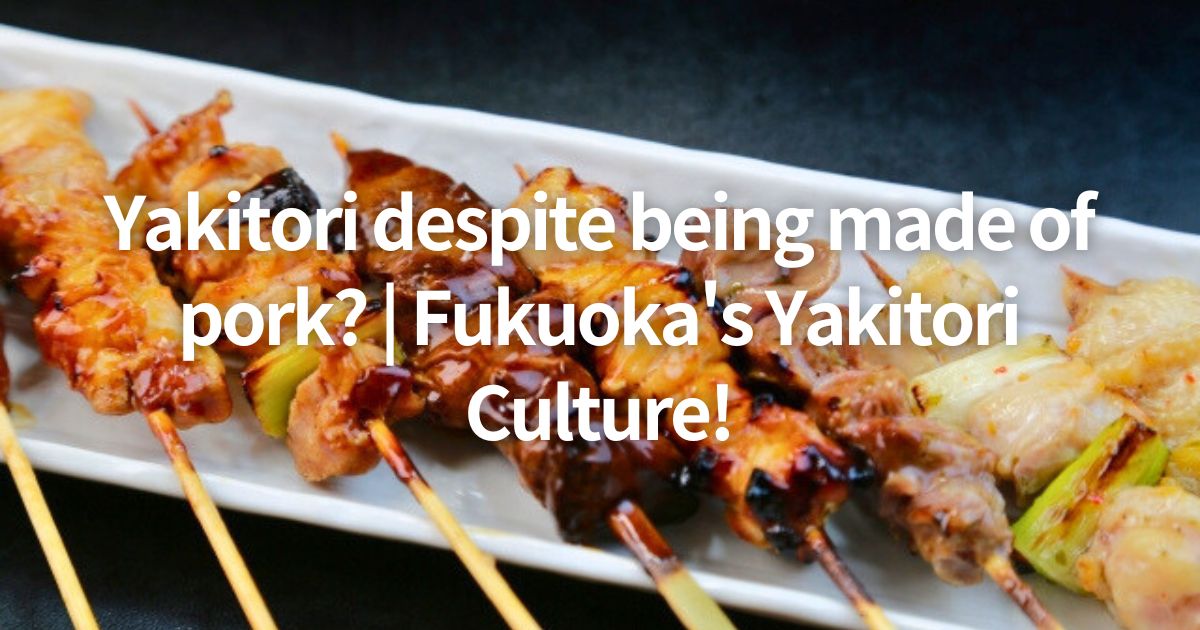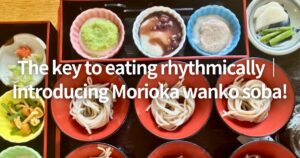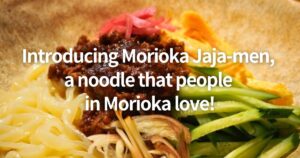It has been a while since I moved to Tokyo, but I still often experience culture chocks due to the differences from when I was a local.
In terms of food, one of them is yakitori.
If you order the recommended set of yakitori in Fukuoka, you will always find pork belly skewers in the set.
Many people from outside of Fukuoka are surprised to see pork belly skewers in yakitori.
In addition, pork belly is so popular in Fukuoka that it is listed first before any other part of the yakitori on the menu.
Fukuoka is also famous for mizutaki, another chicken dish, and is said to have the highest number of yakitori restaurants per 100,000 people in Japan.
So, in this article, I will explain Fukuoka’s yakitori culture, including its history, points of attraction, and recommended specialty restaurants and ways to enjoy it, as well as my own experiences.
I hope you will find this article a good opportunity to learn about Fukuoka’s yakitori culture.
Why is pork belly served at yakitori restaurants in Fukuoka?
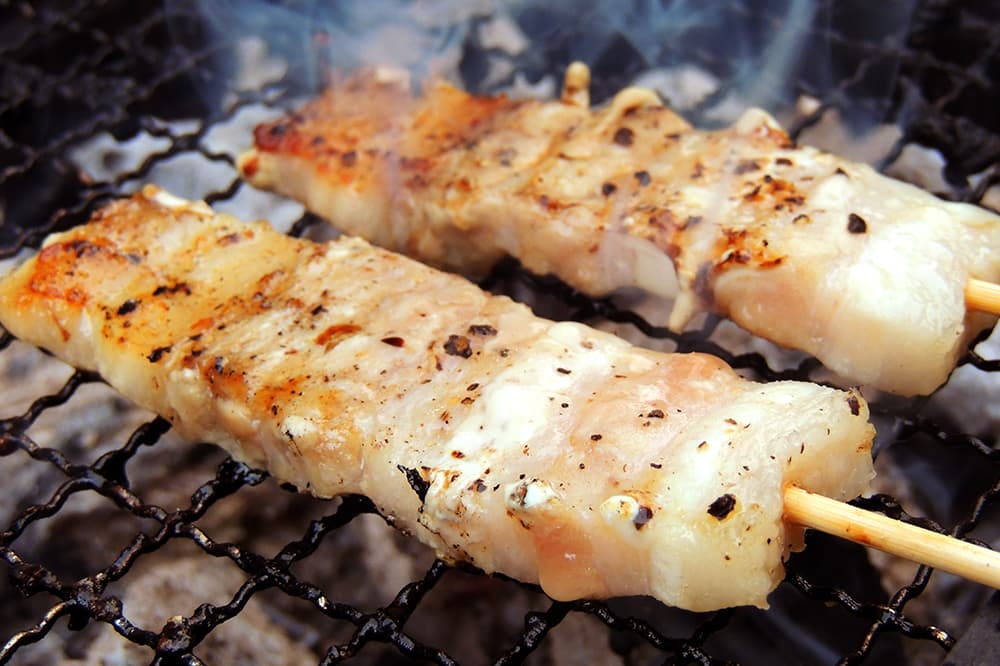

In Fukuoka, “pork belly” is a standard menu item at yakitori restaurants.
Although there is a contradiction in the term “yakitori” in that it is pork and not chicken, the idea that “anything skewered and grilled is yakitori” is deeply rooted in Fukuoka.
Pork belly is so indispensable to Fukuoka residents that it is said there is no one who does not order it when visiting a yakitori restaurant.
There is a theory about this culture that it was brought back from the continent by people repatriated from Manchuria and other areas after World War II.
In Kurume City, Fukuoka Prefecture, in particular, the culture calls all skewered and grilled foods, whether meat or fish, “yakitori.
How are yakitori restaurants in Fukuoka different from those in other prefectures?
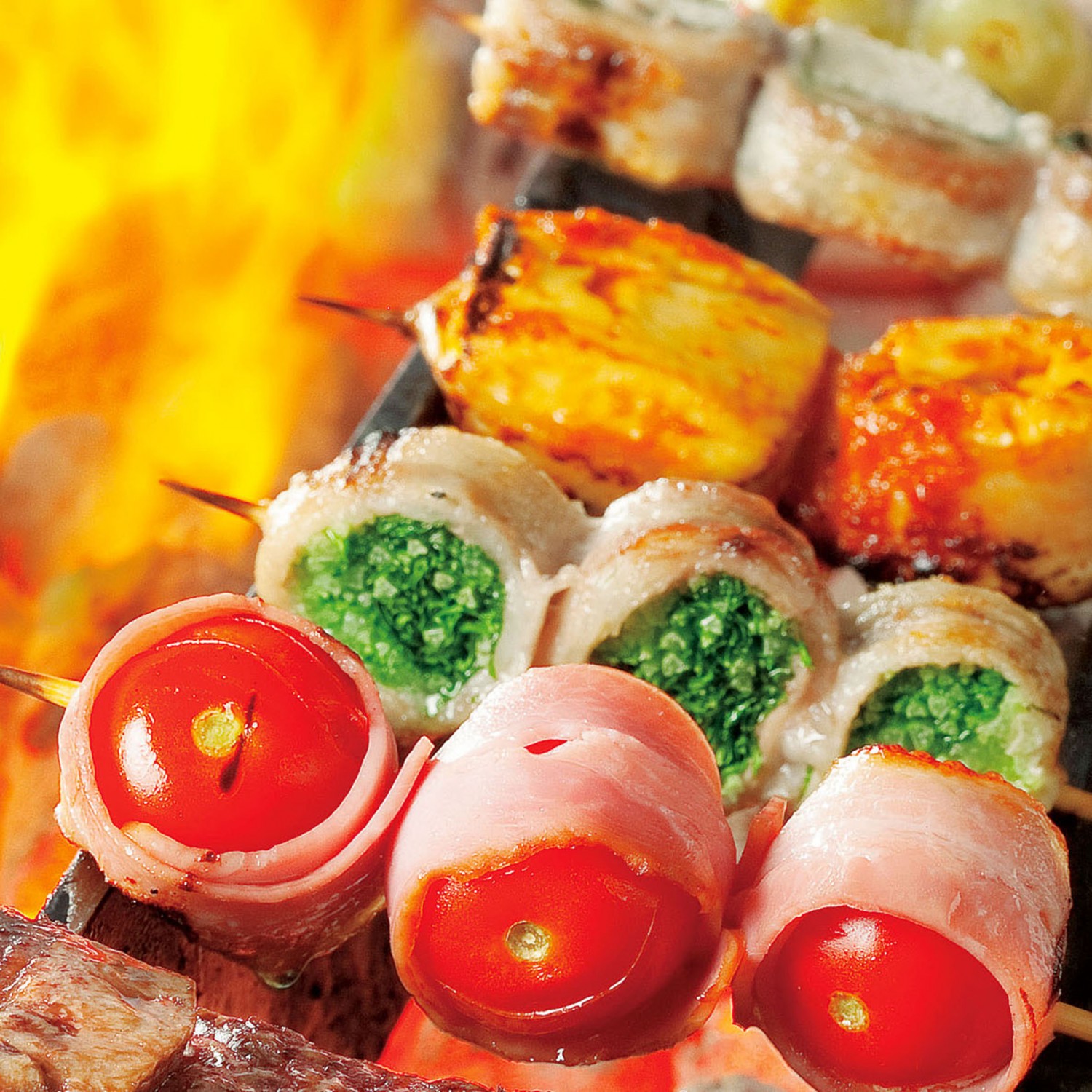

Fukuoka’s yakitori culture has unique characteristics compared to other prefectures.
First, it boasts the highest number of yakitori restaurants among the 21 largest cities, and also tops the list in terms of the number of yakitori restaurants per 100,000 population.
When ordering yakitori, you are served a large plate of cabbage with ponzu sauce, and you can have another plate of cabbage for free.
This is a culture unique to Fukuoka.
Pork belly” is a staple in Fukuoka, and there are many other skewers unique to Fukuoka, such as ‘vegetable rolls’ and ”chicken skin.
In particular, “vegetable rolls” are thinly sliced pork belly wrapped with various vegetables, a unique Fukuoka characteristic not often seen in Tokyo.
Wow. I thought it was common to call the pork belly skewer “yakitori,” but I guess that’s only in Fukuoka…
Three Attractions of Fukuoka’s Yakitori Culture
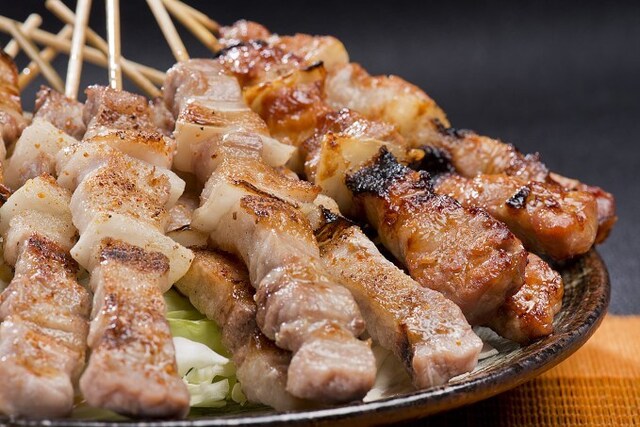

I have summarized some of the attractions of Fukuoka’s yakitori culture.
Pork belly is also the most popular menu item of yakitori
One of the surprising things about yakitori restaurants in Fukuoka is that “pork belly” is served as a standard menu item.
In Fukuoka, yakitori means “pork belly,” and there is hardly a person in the prefecture who does not order pork belly when visiting a yakitori restaurant.
This is a food culture unique to Fukuoka, and visitors from other prefectures may be surprised to hear, “Pork belly in yakitori?
Visitors from other prefectures may be surprised to hear that “yakitori is yakitori, but pork?
In Fukuoka Prefecture, the concept of “yakitori = pork belly” has taken root, and it is said that this concept has its roots in Kurume yakitori, a local dish in Kurume City.
Yakitori is not limited to chicken meat, but is called yakitori for anything that is skewered and grilled, with pork belly being the most popular of the ingredients.
Thickly sliced pork belly and onions are skewered and grilled, and salt seasoning is the most popular flavor.
It is such a popular menu item that each person eats an average of five skewers.
Cabbage and its role in serving yakitori
At yakitori restaurants in Fukuoka, cabbage with ponzu sauce is served on a platter when ordered, and grilled skewers are placed on top of it in turn.
Most restaurants offer a generous free refill of this cabbage.
This ponzu-drenched raw cabbage is said to have originated at “Nobuhide Honten” in Nakasu, and is eaten as a chopstick rest between servings of yakitori to refresh the palate.
It is said that this cabbage makes yakitori more palatable when eating yakitori, which is often greasy.
When visiting yakitori restaurants in other prefectures, Fukuoka residents are often surprised to hear, “Why don’t they serve cabbage?
Cabbage is an indispensable part of Fukuoka’s yakitori culture.
Try to make good use of cabbage as a way to enjoy delicious yakitori.
Chicken skin and its unique food culture
Some famous restaurants are credited with establishing the “torikabe culture” in Fukuoka, and chicken skin is an essential part of the yakitori menu in Fukuoka.
Fukuoka residents love “torikabe” (chicken skin), and it is a common sight to see them ordering large quantities of chicken skin along with pork belly.
In a typical chicken skin preparation, thick and deeply delicious neck skin is used, and the process of marinating it in sauce and grilling it is repeated seven times over a period of six days to remove excess fat.
This process produces a unique texture that is crispy on the outside and chewy on the inside, making it so popular that people say, “I can eat as much as I want.
When visiting Fukuoka, there are many specialty restaurants where you can taste this famous “torikawa” (chicken skin).
Among the yakitori culture of Japan, the chicken skin loved in Fukuoka will be a new dining experience for foreign visitors to Japan.
If you visit Fukuoka, I recommend that you start by ordering the pork belly skewer.
My 3 recommendations for the best yakitori restaurants in Fukuoka
In this article, I will introduce my favorite yakitori restaurants in Fukuoka and their recommended menus.
My Recommendations for Yakitori Restaurants in Fukuoka
My Recommendations for Yakitori Restaurants in Fukuoka
Yakitori no Hachibei
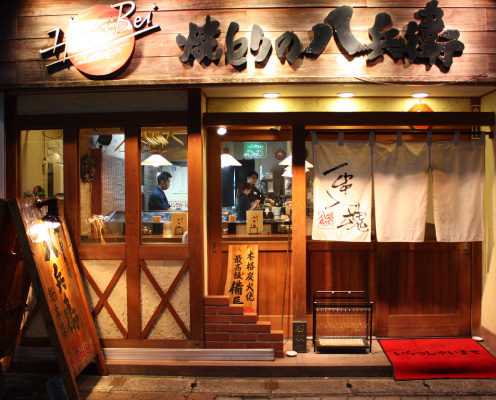

✅ Recommended Points
- This long-established restaurant was founded in 1940 as a butcher store in Itoshima, Fukuoka Prefecture, and opened in 1983 as a yakitori restaurant using butcher store meat.
- Under the concept of “BUTABARA TO THE WORLD,” it is now a popular restaurant with multiple locations in Fukuoka City and also overseas.


✅ Recommended menu
- Beautifully grilled pork belly
- Pork belly is grilled over binchotan charcoal, sprinkled with salt, and finished with a unique cooking method of spraying it with pure sake.
- The delicious flavor and savory aroma of the pork whets the appetite and makes you want to order “one more.
- The yakitori is grilled at high temperatures using binchotan charcoal and sprayed with junmai sake, making it a perfect match with wine.
- We hope you will try our pork belly skewers, which represent Fukuoka’s best.
Hakata Kawaya
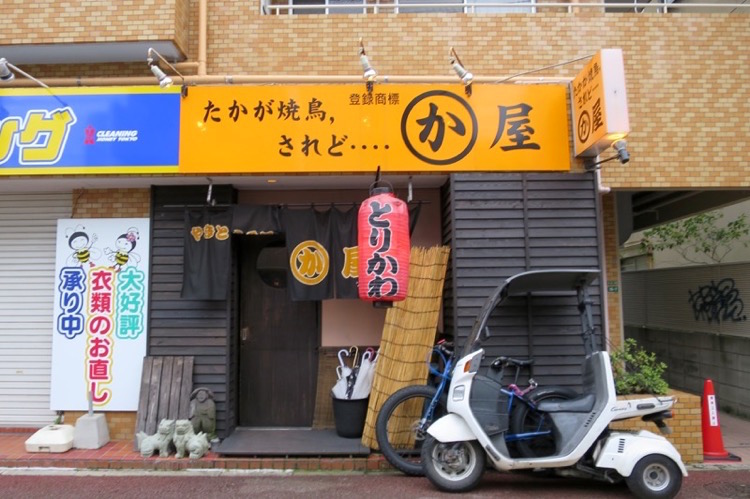

✅ Recommended Points
- Hakata Kawaya is known as the restaurant that established the “torikawa (chicken skin) culture” in Fukuoka.
- It is popular among the locals as a yakitori restaurant where you can enjoy Fukuoka’s famous torikawa (chicken skin).
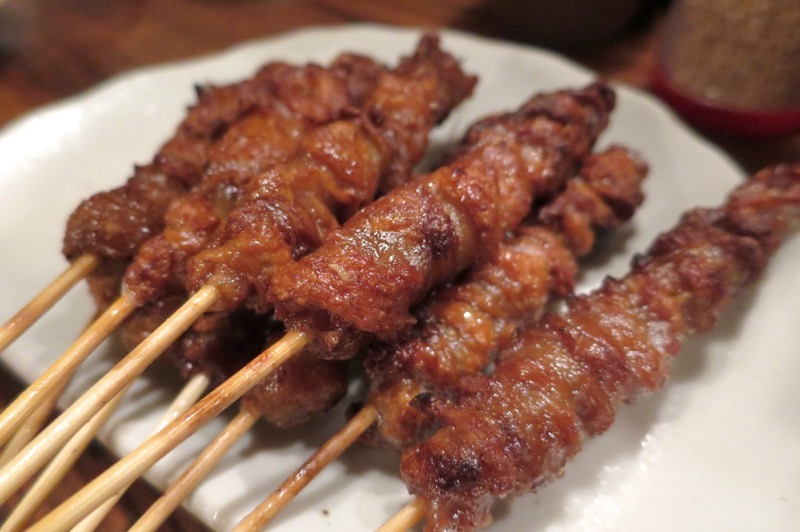

✅ Recommended menu
- Chicken skin
- The famous torikawa (chicken skin) is characterized by its unique texture, crispy on the outside and chewy on the inside, and is popular among customers who say they can eat it as much as they want.
- The skin of the neck, which is thick and has a deep flavor, is marinated in sauce and grilled seven times over a six-day period to remove excess fat.
- This time-consuming cooking method is the secret to the deliciousness of torikawa.
- If you visit Fukuoka, you should not miss Hakata Kawaya’s “Torikawa” (chicken skin).
Yakitori no Hibiki
✅ Recommended Points
- This izakaya is located in Watanabe-dori, Chuo-ku, Fukuoka City, in the deep spot known to those in the know as Sankaku Ichiba.
- It is a local izakaya that is well known for its excellent yakitori served in a retro atmosphere.
✅ Recommended menu
- Yotsumi and Hakata no Gurukawa
- The menu, centering on yakitori, is all very cost-effective, and the size of the yotsumi (thigh meat) and mune (breast meat) is particularly astonishing.
- A la carte dishes are also available, and their slightly strong flavors are popular with customers, as they are sure to be a great accompaniment to alcoholic drinks.
- Yotsumi” refers to the thigh meat, which is a very active part of the chicken and is characterized by its firmness and elasticity.
- Hakata no Gurukawa” is another popular menu item, offering a full taste of the local Fukuoka yakitori culture.
- You can enjoy authentic Fukuoka yakitori at a reasonable price.
I’ve never had authentic Fukuoka chicken skin, so I’ll try it next time I go there! Totally.
Column: Is it true that chicken breast is a beauty food?
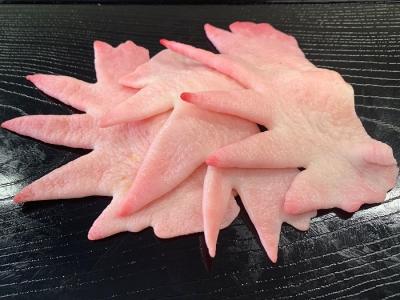

Chicken’s stem is rich in natural hyaluronic acid and collagen, and is attracting attention as a beauty food.
Chicken’s stem is a raw material that contains hyaluronic acid and collagen, which exist everywhere in the body and are said to be the source of youth, in ultra-low molecular weight form that is easily absorbed.
It has a history of being eaten as a beauty food in Western Europe since ancient times.
Beauty supplements using ingredients extracted from chicken’s tassels are enzymatically decomposed at room temperature to make them ultra-low molecular weight, thereby increasing the absorption rate into the body.
The effectiveness of this product is being recognized scientifically, as it has actually been monitored and tested in a study conducted at Otsuma Women’s University and has been the focus of attention in research presentations in the United States.
For those who are concerned about beauty, chicken broth is an effective food.
Wow. I didn’t think you could eat chicken clover, and I didn’t know it was good for you, too… It takes courage to eat it.
How to enjoy yakitori restaurants in Fukuoka
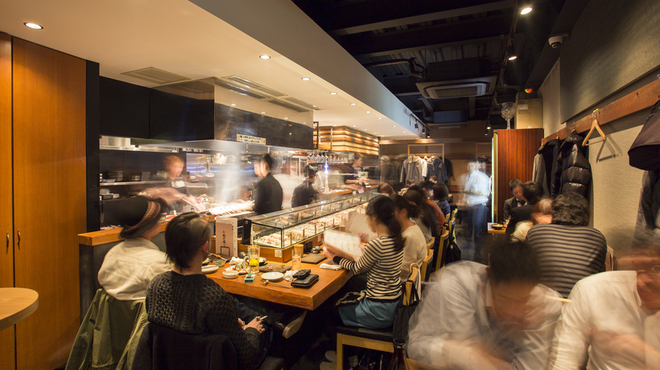

To enjoy yakitori restaurants in Fukuoka to its fullest, try these tips:
✅ Enjoying Yakitori with Fukuoka-style “Hashigo-zake
Fukuoka has the largest number of yakitori restaurants per population in Japan, especially in the Nakasu and Tenjin areas.
Fukuoka City boasts 495 yakitori restaurants, ranking first among the 21 largest cities.
Hashigo-zake” is a way to enjoy yakitori by taking advantage of this high density of restaurants.
The time spent at each yakitori restaurant in Fukuoka is short, and the culture of visiting multiple restaurants is deeply rooted in the city.
Start with a place where you can enjoy pork belly and chicken skin, then go to a famous yakitori restaurant that serves vegetable rolls, and finally to a restaurant where you can enjoy creative yakitori dishes.
Let’s experience the “Fukuoka style” of taking a bite of cabbage, eating pork belly, and thinking about the next menu item.
We also recommend asking the locals about their favorite courses.
✅ End your yakitori party at “Hakata Te-Ippon
Hakata Te Ippon” is a unique closing dish in Fukuoka culture.
At the end of a banquet, when the boss says, “Well, let’s close the party with Te-Ippon,” the participants stand up and start clapping their hands in a unique way.
This ritual of clapping hands in the rhythm of “yo o” (panpan), “mo hitotsu” (panpan), and “ioute sando” (papanpan) is a traditional form of closing that represents a “no objection” agreement.
If you have the opportunity to dine with the locals at a yakitori restaurant in Fukuoka, you should definitely experience this Hakata Te-Ippon.
The locals will be delighted to see foreign tourists participating, and it will be a memorable Fukuoka cultural experience.
It is also recommended to ask the staff of a yakitori restaurant to teach you how to do the “Hakata Te-Ippon”.
✅ Explore the diversity of vegetable rolls
One of the unique features of Fukuoka’s yakitori culture is the abundant variety of “vegetable rolls.
Vegetable rolls, which consist of thinly sliced pork belly wrapped around a variety of vegetables, are served at more than 60 restaurants in Fukuoka City alone and have become a staple menu item at yakitori restaurants.
You can enjoy various vegetables such as lettuce, leek, lotus root, tomato, okra, eggplant, avocado, pea shoot, zucchini, chives, and potherb mustard wrapped in thinly sliced pork belly.
Some restaurants have come up with creative combinations, such as pak choi, spicy lotus root, and even fruits such as strawberries and kiwi.
Popular mainly among women, vegetable rolls are healthy yet satisfying, and each restaurant’s individuality and originality can be felt.
Experience Fukuoka’s unique yakitori culture, which is rarely seen in Tokyo.
The side dishes placed at each restaurant are different, so try to find your own way to arrange them to suit your taste at each restaurant.
Let’s go to Fukuoka to enjoy the real taste!
The best way to enjoy Fukuoka’s yakitori is to go there and enjoy the atmosphere, so I would like to recommend some items that would be great to bring along on your trip.
In this article, I will introduce some of my recommended travel items that can be purchased on Amazon.
Please use them as a reference when considering travel items.
If you are interested, check out the following products on Amazon!









